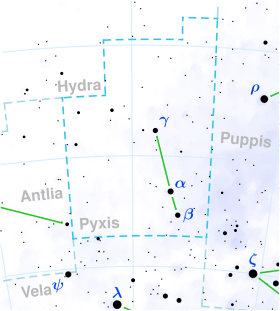| Observation data Epoch J2000 [1] Equinox J2000 [1] | |
|---|---|
| Constellation | Pyxis |
| Right ascension | 08h 39m 17.89867s |
| Declination | −22° 39′ 42.8283″ |
| Apparent magnitude (V) | 5.17 (combined) [2] |
| Characteristics | |
| Spectral type | (G5IV + unknown) + K0V or GV [3] |
| B−V color index | 0.83 [2] |
| J−H color index | 0.456 [4] |
| J−K color index | 0.461 [4] |
| Astrometry | |
| Radial velocity (Rv) | 52.13 ± 0.22 [5] km/s |
| Proper motion (μ) | RA: −240.319 [1] mas/yr Dec.: 459.973 [1] mas/yr |
| Parallax (π) | 50.9663±0.3068 mas [1] |
| Distance | 64.0 ± 0.4 ly (19.6 ± 0.1 pc) |
| Absolute magnitude (MV) | 3.83 (A), 5.28 (B) [6] |
| Orbit [3] | |
| Primary | HD 73752 Aa |
| Companion | HD 73752 Ab |
| Period (P) | 211.76±0.17 d |
| Semi-major axis (a) | ≥(8.83±0.16)×106 km |
| Eccentricity (e) | 0.210±0.016 |
| Periastron epoch (T) | 56372.6±2.7 |
| Argument of periastron (ω) (secondary) | 142.9±4.9° |
| Orbit [7] | |
| Primary | HD 73752 A |
| Companion | HD 73752 B |
| Period (P) | 127 yr |
| Semi-major axis (a) | 1.69" (34 AU [8] ) |
| Eccentricity (e) | 0.32 |
| Inclination (i) | 167° |
| Longitude of the node (Ω) | 211° |
| Periastron epoch (T) | 1986 |
| Argument of periastron (ω) (secondary) | 124° |
| Details [6] | |
| HD 73752 Aa | |
| Mass | 1.21 M☉ |
| Radius | 1.68 R☉ |
| Luminosity | 2.31 [a] L☉ |
| Surface gravity (log g) | 4.07 cgs |
| Temperature | 5680 K |
| Metallicity [Fe/H] | 0.32 dex |
| Rotational velocity (v sin i) | 3.3±0.5 [9] km/s |
| Age | 7 Gyr |
| HD 73752 B | |
| Mass | 1.04 M☉ |
| Radius | 1.01 R☉ |
| Luminosity | 0.608 [a] L☉ |
| Surface gravity (log g) | 4.45 cgs |
| Temperature | 5340 K |
| Other designations | |
| BD−22°2345, CD−22°6442, Gaia DR2 5702029063555481088, Gaia DR3 5702029029197580160, GC 11877, GJ 314, HD 73752, HIP 42430, HR 3430, SAO 176226, PPM 254900, WDS J08391-2240AB, LTT 3202, TIC 118486580, 2MASS J08390794-2239427, WISE J083907.75-223936.6, WISEA J083907.74-223937.4, ADS 6914 AB [10] | |
| Database references | |
| SIMBAD | The system |
| A | |
| B | |
HD 73752 is a multiple star system located in the southern constellation of Pyxis. With an apparent magnitude of 5.17, it can be faintly seen by the naked eye from Earth as a yellow-hued dot of light. As such, it is listed in the Bright Star Catalogue as HR 3430. It is located at a distance of approximately 64.0 light-years (19.6 parsecs) according to Gaia EDR3 parallax measurements, and is receding at a heliocentric radial velocity of 52.13 km/s.
